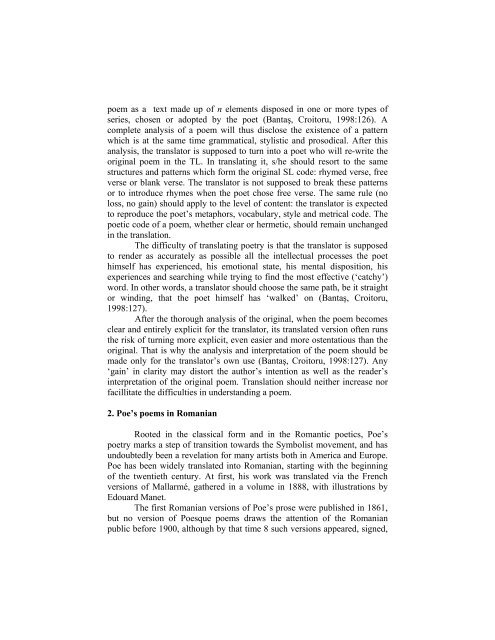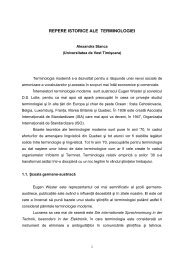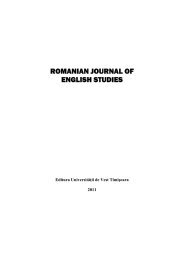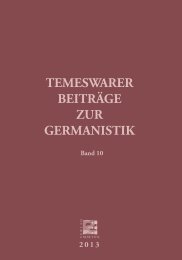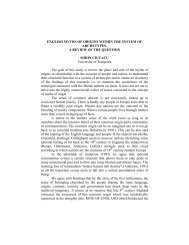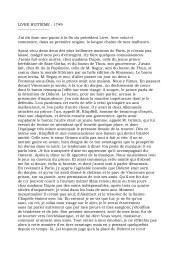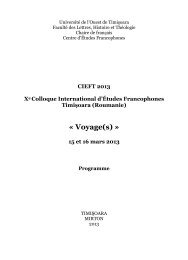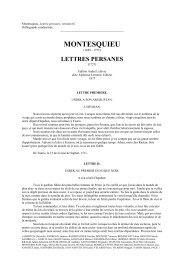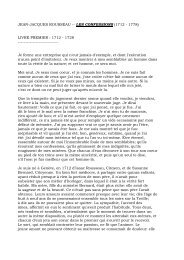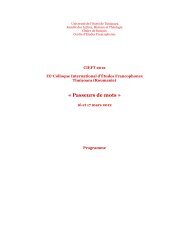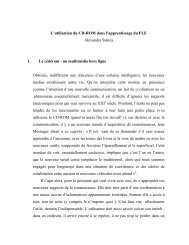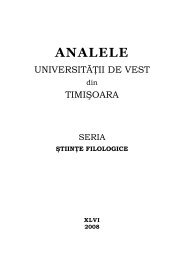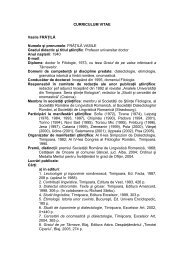TRANSLATION AND MEANING: A CULTURAL- COGNITIVE ...
TRANSLATION AND MEANING: A CULTURAL- COGNITIVE ...
TRANSLATION AND MEANING: A CULTURAL- COGNITIVE ...
Create successful ePaper yourself
Turn your PDF publications into a flip-book with our unique Google optimized e-Paper software.
poem as a text made up of n elements disposed in one or more types of<br />
series, chosen or adopted by the poet (Bantaş, Croitoru, 1998:126). A<br />
complete analysis of a poem will thus disclose the existence of a pattern<br />
which is at the same time grammatical, stylistic and prosodical. After this<br />
analysis, the translator is supposed to turn into a poet who will re-write the<br />
original poem in the TL. In translating it, s/he should resort to the same<br />
structures and patterns which form the original SL code: rhymed verse, free<br />
verse or blank verse. The translator is not supposed to break these patterns<br />
or to introduce rhymes when the poet chose free verse. The same rule (no<br />
loss, no gain) should apply to the level of content: the translator is expected<br />
to reproduce the poet’s metaphors, vocabulary, style and metrical code. The<br />
poetic code of a poem, whether clear or hermetic, should remain unchanged<br />
in the translation.<br />
The difficulty of translating poetry is that the translator is supposed<br />
to render as accurately as possible all the intellectual processes the poet<br />
himself has experienced, his emotional state, his mental disposition, his<br />
experiences and searching while trying to find the most effective (‘catchy’)<br />
word. In other words, a translator should choose the same path, be it straight<br />
or winding, that the poet himself has ‘walked’ on (Bantaş, Croitoru,<br />
1998:127).<br />
After the thorough analysis of the original, when the poem becomes<br />
clear and entirely explicit for the translator, its translated version often runs<br />
the risk of turning more explicit, even easier and more ostentatious than the<br />
original. That is why the analysis and interpretation of the poem should be<br />
made only for the translator’s own use (Bantaş, Croitoru, 1998:127). Any<br />
‘gain’ in clarity may distort the author’s intention as well as the reader’s<br />
interpretation of the original poem. Translation should neither increase nor<br />
facillitate the difficulties in understanding a poem.<br />
2. Poe’s poems in Romanian<br />
Rooted in the classical form and in the Romantic poetics, Poe’s<br />
poetry marks a step of transition towards the Symbolist movement, and has<br />
undoubtedly been a revelation for many artists both in America and Europe.<br />
Poe has been widely translated into Romanian, starting with the beginning<br />
of the twentieth century. At first, his work was translated via the French<br />
versions of Mallarmé, gathered in a volume in 1888, with illustrations by<br />
Edouard Manet.<br />
The first Romanian versions of Poe’s prose were published in 1861,<br />
but no version of Poesque poems draws the attention of the Romanian<br />
public before 1900, although by that time 8 such versions appeared, signed,


